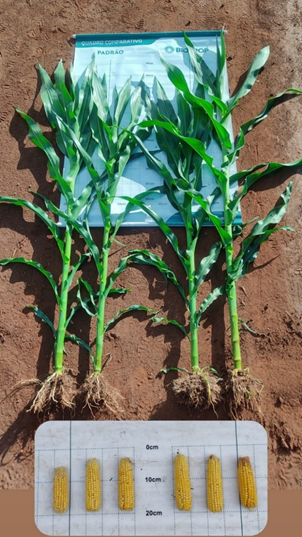Management with biologicals in corn crop
In Brazil, the cultivation of corn (Zea mays L.) is of great commercial importance, being carried out in two seasons: the first crop, during the summer, and a second crop (safrinha) during the autumn/winter. Both crops are conducted under different environmental conditions, but equally exposed to biotic and abiotic factors that influence their development and productivity. Attention to crop management is essential to achieve good yields and profitability, rain conditions, temperature, incidence of pests and diseases, among other factors other than crop by crop, requiring the producer to be constantly aware of its management.
When to start biological management?
Biological management in maize crops must be started before planting, in seed treatment using inoculants based on Azospirillum spp. This bacterium acts in the biological adaptation of nitrogen, promotes plant growth, in addition to increasing the activity of the nitrate reductase enzyme, producing plant hormones (auxins), and acting to benefit the soil microbiota.
Main reasons to use biologicals
In the field, fungi present in seeds manifest themselves, causing substantial losses in the establishment of the crop and crop development and, consequently, negatively affecting the productivity and quality of the produced seeds. Therefore, the practice of seed treatment, especially with biocontrol agents, is widely recommended to contain the spread of diseases and achieve a better initial stand of the crop, with good plant density.
control agents
The use of biological control agents in seed treatment is also aimed at the management of diseases transmitted via seeds, such as root or stem rots (Fusarium verticillioides; Diplodia maydis; Pythium spp.;). The main characteristic of pathogens is that they invade the grain in the pre-harvest stage, or the ear, in the post-harvest stage, before threshing.
Left: no biological management.
Right: with biological management. Photo: Beltrame, V. (2021).
Is it possible to carry out biological management for aerial part diseases?
Biological management is also recommended for aerial part diseases, such as leaf spots and rust. In this case, the microorganism is applied via the leaves, acting through its various mechanisms of action in the biological control of diseases. One of these modes of action is an ability to stimulate plants to develop induced systemic resistance (ISR), which is the activation of the plants' natural defense system. Other mechanisms of action of biological solutions are: competition for space and nutrients, antibiosis, predation and parasitism.
Is there biological management for insects?
Yes! Exists!
This management can be carried out with the use of microorganisms, macro-organisms (natural enemies), plant extracts, essentials and other substances of organic origin that present effective mechanisms of action in the management of pests. Among the mechanisms of action already known to biologicals, of direct or indirect action, we can mention predation, repelling action, dislodging action, insecticide action, pest colonization action, among others.
Conclusion
The increased use of microorganisms in agriculture must be due to the proven beneficial effect they exert on plants and the environment and efficiency in the management of folds and diseases of bringing additional benefits such as promoting plant growth, solubilization and mobilization of nutrients, activation of the plant defense system etc. The search for more sustainable and cost-effective methods for the producer has leveraged the market for biological inputs in Brazil, through the use of inoculants and biochemicals in the corn crop.
Support:





